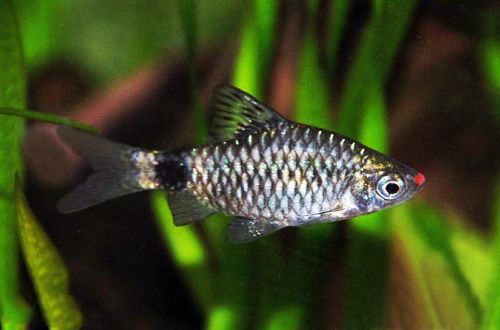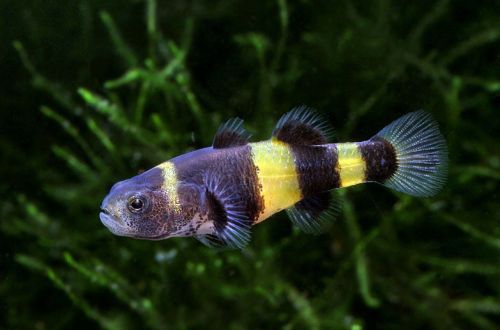
Nannostomus Harrison
Harrison’s Nannostomus or Black-banded Nannostomus, scientific name Nannostomus harrisoni, belongs to the Lebiasinidae family. The fish is named after the scientist James Harrison, who actively assisted the expedition organized by the University of Indiana and the Carnegie Museum, during which this species was discovered.
Contents
Habitat
Comes from South America. Presumably endemic to the Demerara River Basin in eastern Guyana. Inhabits small rivers and slow-flowing streams, swamps and floodplain lakes. A typical biotope is a reservoir with an abundance of aquatic vegetation, many snags, the bottom is littered with plant remains and fallen leaves.
Brief information:
- The volume of the aquarium – from 50 liters.
- Temperature – 22-28°C
- Value pH — 5.0–7.0
- Water hardness – 1–10 dGH
- Substrate type – any
- Lighting – subdued, moderate
- Brackish water – no
- Water movement – moderate
- The size of the fish is about 4 cm.
- Food – any food
- Temperament – peaceful
- Content in a group of 10 individuals
Description
Adults reach a length of about 4 cm. The fish have an elongated body and a pointed head. The eyes are disproportionately large. Males, in contrast to females, look somewhat slimmer and have red pigmentation at the base of the tail and anal fin. The color is silvery with a wide black stripe.
Food
The home aquarium will accept a variety of foods. The basis of the diet can be dry food in the form of flakes, granules, however, you should regularly feed live or frozen brine shrimp, daphnia and small bloodworms, etc.
Maintenance and care, arrangement of the aquarium
The optimal size of an aquarium for a flock of 10 fish starts from 50-60 liters. Harrison’s nannostomus are desirable to be kept in an environment resembling their natural habitat. The most harmonious fish will look among snags and dense thickets of aquatic plants, including floating ones, around which they like to gather. The lighting is subdued, so shade-loving plant varieties are used.
An important, although not mandatory element of the design are the leaves of some trees, placed at the bottom. When they decompose, processes similar to those observed in natural reservoirs occur – the water is saturated with tannins and acquires a characteristic brown tint. In addition, the leaves serve as the basis for the development of a colony of beneficial microorganisms, in particular shoe ciliates – a valuable secondary food source for fry.
Long-term successful management depends on providing stable water conditions within an acceptable range of hydrochemical values. To this end, the aquarium is equipped with all the necessary equipment, weekly they replace part of the water with fresh water, clean it from organic waste, and carry out other mandatory procedures.
Behavior and Compatibility
A peaceful and even timid schooling fish, it cannot be combined with large and overly mobile species. It is desirable to maintain a group size of at least 10 individuals, in this number Nannostomus behave more naturally. Apistograms and other small American cichlids, Corydoras catfish and others are suitable as aquarium neighbors.
Breeding / breeding
Breeding is associated with a number of difficulties associated with both the creation of favorable conditions and the behavior of fish during the mating season. However, the hardest part is saving the fry. If the fish are in a suitable environment and receive high-quality food rich in proteins, then they quickly come to a spawning state. Males begin active courtship, competing with each other for the right to be the first to fertilize the eggs, which the females randomly scatter over the surface.
Parental instincts are not developed. Adult fish immediately after spawning can eat their own eggs and fry that have appeared. For their safety, experienced aquarists plant dense thickets of low-growing plants or mosses on the bottom, for example, Java moss, or an artificial spawning substrate. Eggs caught among plants are more likely to avoid being eaten.
The incubation period lasts 1-2 days. Fry should be transplanted into a separate tank with identical water conditions, equipped with a simple airlift filter with a sponge and a heater. A separate light source is not required. In the first days of life, juveniles need microscopic food, such as ciliates or special powdered products. In the future, as they grow, they begin to take Artemia nauplii and similar feeds.
Fish diseases
Diseases inherent in this particular species of fish were not noted. When kept in suitable conditions (high water quality, balanced diet, non-conflict neighbors, etc.), health problems are not observed. The most common cause of disease is the deterioration of conditions leading to immune suppression, which makes the fish susceptible to infections that are invariably present in the surrounding area. When the first signs of an illness are detected (lethargy, exhaustion, refusal of food, lowered fins, etc.), it is necessary to immediately check the main parameters of the water. Often, the restoration of acceptable living conditions contributes to self-healing, but if the fish is too weak or has received obvious damage, medical treatment will be required. For more information on symptoms and treatments, see the Aquarium Fish Diseases section.





